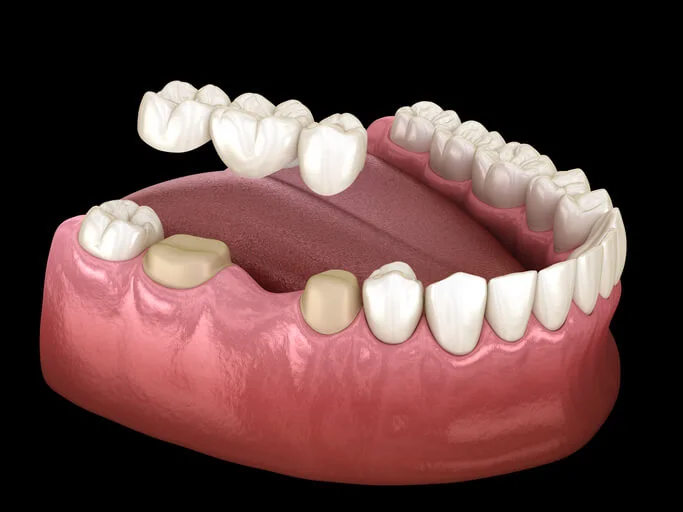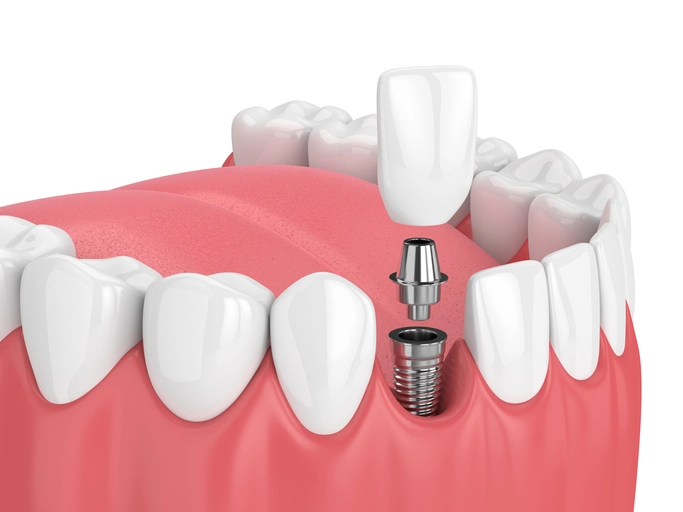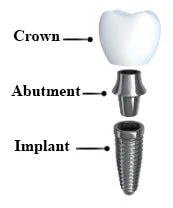
Single Dental Implant
A Single Dental Implant to Replace One Tooth
A single dental implant can replace one missing tooth. A dental implant is a replacement for the root of the tooth, which is essentially a titanium post that is in the bone and holds a crown or replacement tooth. Because of the special design and composition of dental implants, they become securely attached or fused to the patient’s jawbone through a process called “osseointegration”. This process gives dental implant a success rate of about 96%.
Dental implants have success because of the composition of the dental implant surface. Titanium is the main component that leads to the lasting success of the dental implant. Today some implants are also made of zirconium.
After a healing period which allows the bone to grow around and onto the implant surface, the final crown or cap is attached to the implant. These crowns are made using the same procedures as traditional crowns. The materials used to make these crowns are the best that has ever been available.
Dental implant vs Dental Bridge


A dental bridge was a common technique before dental implants were available. A bridge can replace 1 or more teeth. Bridges require the removal of the enamel or outer layer of the tooth on each side of the empty space. One or more teeth on each side of the space are capped or crowned. The replacement teeth are called pontics and are fused to the retainer or anchor teeth. A 3-tooth or 3-unit bridge would have two retainer or anchor teeth on each side of the empty space and one pontic to fill the space. The bridge is permanently cemented. Sometimes the anchor teeth will need to be removed because the root is fractured, or a cavity is too large to fix. If one of the teeth anchor teeth needs to be removed, then the entire bridge usually needs removed.
A single tooth dental implant does not require tooth enamel to be permanently removed from other teeth. The implant is placed where teeth are missing. After a healing period of three to six months, the restorative dentist places the abutment and crown onto the implant. This healing timeline is essential to long-term success. Other teeth are not involved or altered. A dental implant is made of titanium or zirconium which cannot get a dental cavity. This is an advantage of dental implants vs bridges.
Is It Painful?
Dr. Wiland and staff work very hard to limit pain both during and after the dental implant procedures. Patients often experience little to no pain or discomfort. Usually, Tylenol is all that is needed to control discomfort, but stronger medications are available when needed. The amount of pain is related to the amount of work that is accomplished. If the site has enough bone height and width and only requires dental implant placement, then discomfort is minimal. When bone grafting and other more involved procedures are completed, there are several methods to control pain which include the use of pain medication, long-acting anesthetics, ice and minimizing activities. Treatment is customized for each person since not two people are exactly alike, making the experience comfortable and pleasant.
How Long Does an Implant Last?
Implants have over 96% change of lasting the rest of your life. The success rate is lower if you smoke or you have poorly controlled diabetes. Implants must be kept clean to achieve long-term success.
What Are the Implant Parts for One Dental Implant?

The parts for a single dental implant include the dental implant, the abutment, and the crown. A dental implant is the part that is inside of the bone and replaces the root of the tooth. The second part is the abutment that screws inside of the implant after it has healed or integrated with the bone. The abutment is tightened with special instruments to achieve the proper torque. The proper torque allows the abutment to be tightened enough to stay on but also not too tight. The crown is connected or cemented to the abutment. The crown is the replacement for the tooth that was lost. Usually, the restorative dentist will place the abutment and the crown or fake tooth.
What Is the Cost of a Single Dental Implant in Indiana?
The cost of one dental implant can have a wide range. If the area to receive the dental implant has enough height and width of bone, then the cost can be around $3,000.00. This cost is for the dental implant and would not include the abutment or crown. If there is a need to remove a tooth or complete some bone grafting, then the cost of a single implant can be more. However, the implant can last the rest of your life. There is interest free financing available through CareCredit.
What Are the Steps Involved in the Single Tooth Dental Implant Procedure?
- Examination appointment
- Site preparation
- Implant placement
- Healing phase
- Restorative phase
The area to receive a dental implant is examined to be sure there is enough bone in the area. Digital radiographs or x-rays are taken. Dr. Wiland takes his own digital x-rays so he can take measurements on the computer to evaluate the height and width of available bone. Sometimes there is a need for a cone-beam computed tomography (CBCT) image. This will give detailed information about the depth or width of bone. It can provide three-dimensional information (height, width and depth) that is not available with a two-dimensional digital x-ray. If you would like sedation during the procedure, it is available so you are relaxed during treatment. You will be completely numb whether you have sedation or not. There is also a review of which medications work best for you after treatment. The need for a temporary tooth is also evaluated. You are never without a tooth, if you would like a temporary replacement. Temporary teeth fill the space after your tooth is removed and before the final replacement tooth is delivered.
Sometimes the area to receive a dental implant does not have enough bone. A bone graft can be completed to prepare the site for a dental implant. A bone graft allows your body to regenerate or make more bone. Most of the bone graft is removed and replaced by your own bone as the area heals. If this site is allowed to heal before placing a dental implant, it is called a delayed approach to implant placement. Sometimes, the implant can be placed immediately when the tooth is removed. This is called immediate implant placement. An immediate implant may or may not require a bone graft. The need for a bone graft is determined by the thickness and amount of bone that is present. Which type of approach is best for you is customized based on your unique situation.
After the site is prepared the implant is placed. The area is anesthetized or numbed so there is no pain. Frequently, the implant is placed without the need for stitches, making implant placement painless. A single tooth dental implant placement procedure usually takes about one hour.
The implant needs to heal before strong forces are placed on it. This varies with each person and situation. The healing time is usually between three and six months. Remember you can have a temporary replacement tooth while the site heals. Bone needs to form around the implant and mature to become strong before proceeding to the next step in treatment. How well and how fast your bone heals varies. It is important you are not low with vitamin D or calcium during the healing phase. Dr. Wiland may suggest a vitamin D and calcium supplement during bone formation. If you are diabetic, be sure the diabetes is well-controlled. Most importantly, do not smoke. If you have to smoke, then try to minimize smoking as much as possible as this can affect healing and success of the implant. After the implant has healed, there is a final check to make sure the implant is stable and ready to proceed with the final phase of treatment.
You will see your general dentist who will work with a dental lab to make the abutment and crown for your implant. That dentist will deliver the abutment and crown to replace a missing tooth with a dental implant crown.
Are Dental Implants Successful?
The success rate of a single tooth implant is over 96%. For a dental implant to be successful, it must be stable with the surrounding bone. Implant stability is tested with a device call the Osstell Beacon+. This advanced piece of technology uses Resonance Frequency Analysis (RFA) to measures how well an implant has healed before a crown is placed on the implant. You do not need to be numb to use this device. There are more than 1300 studies to support its use. The Osstell Beacon+ is a simple test to determine how well the implant has healed.
1. Jung RE, Pjetursson BE, Glauser R, Zembic A, Zwahlen M, Lang NP (February 2008). "A systematic review of the 5-year survival and complication rates of implant-supported single crowns" (PDF).Clinical Oral Implants Research. 19 (2): 119–30. doi:10.1111/j.1600-0501.2007.01453.x. PMID 18067597. S2CID 13599504.Dr. Wiland is a board certified specialist in the placement of dental implants and places single tooth dental implants at convenient locations in Kokomo, Indianapolis and Richmond, Indiana. He enjoys serving the communities of Greenwood, Franklin and Bloomington, Indiana at his Indianapolis southside office. The Richmond, Indiana location has serves Ohio and East Central Indiana. The Kokomo, Indiana location serves the Logansport, Peru, Greentown, Galveston, Tipton and Rochester, Indiana. Schedule a consultation to see if a single tooth dental implant is the right choice for you.
 Schedule an Appointment
Schedule an Appointment
